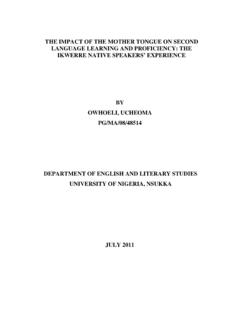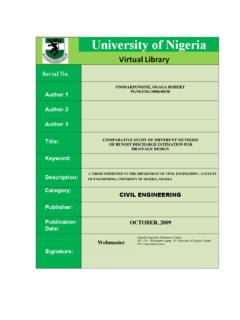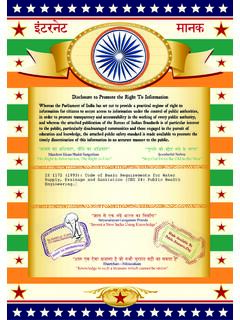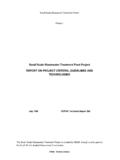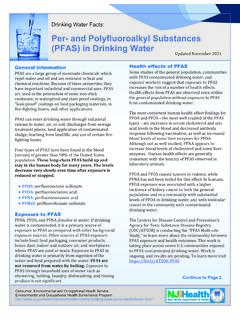Transcription of Water and Waterborne Diseases: A Review
1 See discussions, stats, and author profiles for this publication at: and Waterborne Diseases: A ReviewARTICLE JANUARY 2016 DOI: AUTHORS, INCLUDING:Ozioma Forstinus NwaborUniversity of Nigeria8 PUBLICATIONS 0 CITATIONS SEE PROFILEE mmanuel NnamonuUniversity of Nigeria20 PUBLICATIONS 0 CITATIONS SEE PROFILEPaul MartinsUniversity of Nigeria3 PUBLICATIONS 0 CITATIONS SEE PROFILEA vailable from: Emmanuel NnamonuRetrieved on: 08 January 2016_____ *Corresponding author: Email: International Journal of TROPICAL DISEASE & Health 12(4): 1-14, 2016, Article ISSN: 2278 1005, NLM ID: 101632866 SCIENCEDOMAIN international Water and Waterborne Diseases: A Review Nwabor Ozioma Forstinus1, Nnamonu Emmanuel Ikechukwu2*, Martins Paul Emenike1 and Ani Ogonna Christiana3 1 Department of Microbiology, University of Nigeria, Nsukka, Nigeria.
2 2 Department of Zoology and Environmental Biology, University of Nigeria, Nsukka, Nigeria. 3 Department of Applied Biology, Ebonyi State University, Abakaliki, Nigeria. Authors contributions This Review work was carried out in collaboration between all authors, although the work was masterminded by the first author. All authors read and approved the final manuscript. Article Information DOI: Editor(s): (1) Arun Kumar Nalla, College of Medicine, University of Illinois, Peoria, IL, USA. Reviewers: (1) Rafael A. Mart nez-D az, Universidad Autonoma de Madrid, Spain. (2) Natthanej Luplertlop, Mahidol University, Bangkok, Thailand. (3) S. Thenmozhi, Periyar University, India. Complete Peer Review History: Received 10th September 2015 Accepted 7th November 2015 Published 27th November 2015 ABSTRACT Despite numerous efforts by government at various levels and other agencies interested in Water and its safety, Waterborne diseases are still a major public health and environmental concern.
3 The huge investment towards Water research, although worth the spending, has not yielded the much expected result as Waterborne diseases continue to plague developing countries with Africa and Asia having the worse hit. The unavailability of pipe-borne Water and the dependence of rural dwellers on surface waters which are often contaminated with faecal materials are undoubtedly the major causes of the rising prevalence of Waterborne diseases. Water availability and poor hygienic practices amongst these rural dwellers are also of paramount concern as they play significant roles in the spread of Water -washed diseases. Also, poor environmental practice which encourages the breeding of insects and other forms of vectors within residential areas contribute to the increasing prevalence of Waterborne diseases.
4 This Review focuses on Waterborne diseases, its classification and the various methods employed in the bacteriological analysis of Water . Keywords: Water ; Waterborne disease; bacteriological; conventional; molecular. Review Article Nwabor et al.; IJTDH, 12(4): 1-14, 2016; Article 2 1. INTRODUCTION Countries throughout the world are concerned with the effects of unclean drinking Water because Water -borne diseases are a major cause of morbidity and mortality [1,2]. Clean drinking Water is important for overall health and plays a substantial role in infant and child health and survival [3,4,5,6]. The World Health Organization [7] estimated that globally, about million people die from diarrheal diseases annually, many of which have been linked to diseases acquired from the consumption of contaminated waters and seafood.
5 Persons with compromised immune systems, such as those with AIDS, are especially vulnerable to Water -borne infections, including those infections that are self-limiting and typically not threatening to healthy individuals [8,9]. Throughout the less developed part of the world, the proportion of households that use unclean drinking Water source has declined, but it is extremely unlikely that all households will have a clean drinking Water source in the foreseeable future [10]. UNICEF [11] reports that 884 million people in the world use unimproved drinking Water source, and estimates that in 2015, 672 million people will still use an unimproved drinking Water source. In another report, UNDESA [12] put the worldwide estimate for people without access to safe Water at nearly 900 million.
6 According to WHO/UNICEF [13], about billion, almost half the population of the developing world, do not have access to adequate sanitation . Over 80 per cent of people with unimproved drinking Water and 70 per cent of people without improved sanitation live in rural areas [14]. In Nigeria, a vast majority of people living along the course of Water bodies still source and drink from rivers, streams and other Water bodies irrespective of the state of these Water bodies without any form of treatment. These natural waters contain a myriad of microbial species, many of which have not been cultured, much less identified. The number of organisms present varies considerably between different Water types, and it is generally accepted that sewage-polluted surface waters contain greater number of bacteria than unpolluted waters [15].
7 Polluted surface waters can contain a large variety of pathogenic microorganisms including viruses, bacteria and protozoa [16]. These pathogens, often of fecal source, might be from point sources such as municipal wastewater treatment plants [17,18,19,20,21] and drainage from areas where livestock are handled [22] or from non-point sources such as domestic and wild animal defecation, malfunctioning sewage and septic systems, storm Water drainage and urban runoff [23,24]. Fecal contamination of Water is globally recognized as one of the leading causes of Waterborne diseases. The potential of drinking Water to transport microbial pathogens to great numbers of people, causing subsequent illness, is well documented in countries at all levels of economic development.
8 The outbreak of cryptosporidiosis of 1993 in Milwaukee, Wisconsin, in the United States provides a good example. It was estimated that about 400,000 individuals suffered from gastrointestinal symptoms due, in a large proportion of cases, to Cryptosporidium [25]. Although subsequent reports suggest that this may be a significant overestimation [26]. More recent outbreaks involving Escherichia coli O157:H7, the most serious of which occurred in Walkerton, Ontario Canada in the spring of 2000, resulted in six deaths and over 2,300 cases. The number of outbreaks reported throughout the world demonstrates that transmission of pathogens by drinking Water remains a significant cause of illness.
9 In Nigeria, cases of Water related diseases abound. Agents of these diseases have been found to cut across various classes of organisms. However, most of these cases are not documented since majority of the affected individual subscribes to self-medication rather than seek professional medical attention. The most common Waterborne diseases in Nigeria include Cholera, Dracunculiasis, Hepatitis, and Typhoid [27]. Cases of Water borne diseases linked to contaminations of drinking Water with pathogens have also been reported in several towns [28,29,30]. Waterborne outbreaks of enteric disease occurs either when public drinking Water supplies were not adequately treated after contamination with surface Water or when surface waters contaminated with enteric pathogens have been used for recreational and or domestic purpose [31].
10 Instances of disease outbreak due to contaminated drinking Water with microbes are also reported [32,33] with the drinking waters sampled from Sokoto, Shuni and Tambuwal towns having E. coli, Salmonella, Shigella and Vibrio species far above the WHO [15] allowable limit [32] and are therefore not potable. The role of Water as a vehicle for the transmission of all manner of Water related illnesses is no longer a subject for debate, even ancient histories and books contain extracts indicative of this fact. Table 1 below shows some of the diseases related to Water and sanitation which are endemic in sub Saharan Africa as well as their route of infection. Nwabor et al.; IJTDH, 12(4): 1-14, 2016; Article 3 Table 1.
